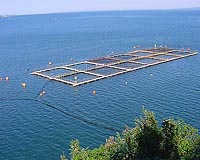 |
Pirbright, UK (SPX) Jan 13, 2010 Scientists from the Institute for Animal Health, Pirbright, UK Met Office and the Jersey State Veterinary Service and Jersey Meteorological Department, are working together on an early-warning system to help defend cattle against the spread of 'bluetongue' disease, reveals a study published in Weather. The team are fusing meteorological data with ecological information to anticipate when disease carrying midges are likely to be carried on the wind from the continent to the UK and Channel Islands. "The bluetongue virus, BTV, represents a major and unprecedented epidemic which has spread across Western Europe since 2006," said lead author Dr Christopher J. Sanders from the Institute for Animal Health. "While accurate estimates of costs incurred are not yet available, it is estimated that these could be in the order of many tens of millions of pounds." BTV is carried by small biting midges, Culicoides, one of the smallest species of biting flies found on livestock. One bite from a midge fully infected with BTV can be enough to lead to infection in cattle and sheep, which can be fatal. Since 1998 the range of the African species of biting midge has expanded from the Mediterranean basin resulting in an overlap with the range of European species. This enabled European species of midge to pick up virus from infected animals for the first time and go on to transmit it in Southern Europe. However, the arrival of BTV in northern Europe in 2006 was independent of this northwards movement of BTV, jumping north rather than from a gradual spread, and was reliant on transmission only by European midges common and widespread in the area. In 2006 the disease was found in Belgium, France, the Netherlands, Luxembourg and Germany; 700 km north of previous European outbreaks. In June 2007 the disease was once again reported in Germany and by October 2008 24,000 cases were reported in France alone. In September 2007, the first cases of BTV were discovered in the UK, where fortunately the outbreak was small. The danger that the disease may again spread to the UK from across the channel is of special concern to the Channel Island of Jersey, which maintains a world renowned cattle industry, but is at heightened risk of infection if the disease becomes established along the Cherbourg peninsula or the Normandy and Brittany coastline. The risk comes from the possibility that the tiny midges can be carried on the wind from the French coast to the Island. To monitor this threat the team set up midge light traps in farms across the island to monitor midge activity and to identify the presence of any potential vector species. The results were then collated and analysed alongside data from the Jersey Meteorological Department, which allowed the team to pinpoint when livestock were at risk from a number of locations on the mainland. This information was fed into the UK Met Office early-warning website which has also been used on the mainland to help predict and defend against the disease. "Environmental conditions, especially temperature, wind speed and direction have a significant impact on the biting midge in terms of activity and abundance," concluded Sanders. "Monitoring the midge population in Jersey will provide the farming community on the mainland with knowledge of when the midge season commences in the diseased areas of the near continent."
Share This Article With Planet Earth
Related Links Institute for Animal Health, Pirbright Farming Today - Suppliers and Technology
 Chile plans deepwater salmon farm
Chile plans deepwater salmon farm Santiago, Chile (UPI) Jan 12, 2009 Chile will launch its first deepwater salmon farming project with a Norwegian loan to try and reverse the low yields on salmon amid constant global demand. The offshore project is the brainchild of a Chilean business group that has been pledged $40 million by Norwegian banks, with the promise it can have access to more funds if the venture takes off. Disease and economic downtur ... read more |
|
| The content herein, unless otherwise known to be public domain, are Copyright 1995-2009 - SpaceDaily. AFP and UPI Wire Stories are copyright Agence France-Presse and United Press International. ESA Portal Reports are copyright European Space Agency. All NASA sourced material is public domain. Additional copyrights may apply in whole or part to other bona fide parties. Advertising does not imply endorsement,agreement or approval of any opinions, statements or information provided by SpaceDaily on any Web page published or hosted by SpaceDaily. Privacy Statement |